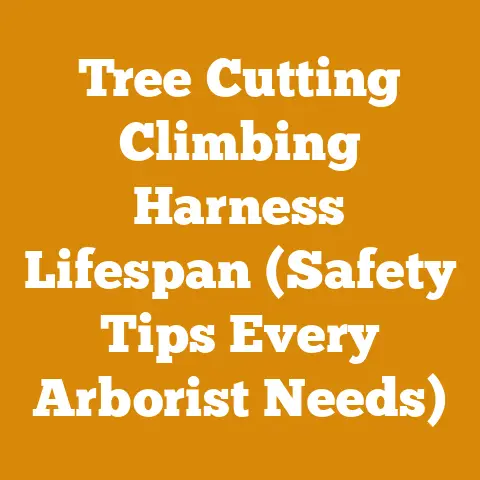Small Tree Cutting Techniques: Pro Tips for Cleaner Felling (5 Hacks)
Ever wondered how to fell small trees safely and efficiently, leaving the forest floor cleaner than a whistle?
I’ve spent years wrestling with timber, from saplings barely thicker than my wrist to seasoned giants.
And let me tell you, even the smallest tree demands respect and a well-thought-out approach.
Today, I’m going to share five pro hacks that will not only make your small tree cutting safer and easier but also minimize environmental impact.
These aren’t just theoretical; they’re born from real-world experience, countless hours in the woods, and a few hard-learned lessons along the way.
Small Tree Cutting Techniques: Pro Tips for Cleaner Felling (5 Hacks)
1. The Pre-Felling Assessment: Know Your Target
Before you even think about firing up your chainsaw, take a good, hard look at the tree.
This isn’t just about glancing; it’s about a detailed assessment.
I’ve seen too many accidents happen because people rush into a cut without understanding the tree’s lean, weight distribution, and potential hazards.
- Lean: Is the tree leaning in a particular direction?
This is your primary factor.
A tree will naturally fall in the direction of its lean.
If it’s leaning heavily, that’s where it’s going. - Weight Distribution: Is the crown heavier on one side?
This will influence the fall, even against a slight lean.
Look for branches that are significantly larger or more numerous on one side. - Dead or Broken Branches (Widow Makers): These are incredibly dangerous.
A seemingly insignificant dead branch can snap and fall unexpectedly, causing serious injury.
I recall a time in the Adirondacks where a small, seemingly harmless maple had a hidden broken branch high in its crown.
As I started my back cut, the vibration caused it to break free and come crashing down.
Luckily, I was far enough away, but it was a sobering reminder to always check above. - Surrounding Obstacles: Are there other trees, rocks, or power lines nearby?
These can obstruct the fall and create a dangerous situation.
Pay special attention to saplings you want to protect; a carelessly felled small tree can easily damage or destroy them. - Wind: Even a light breeze can significantly alter the tree’s fall.
In windy conditions, consider postponing the cutting or adjusting your technique accordingly.
Remember, wind speed increases with height.
A gentle breeze at ground level can be a strong gust in the tree’s crown. - Species Identification: Knowing the species is crucial.
Different wood types have different densities and strengths, affecting how they fall and split.
For instance, a seasoned oak is going to behave very differently from a poplar of the same size.
Data Point: According to the ANSI Z133 safety standard for tree care operations, a pre-work inspection must be conducted before any tree-felling operation to identify hazards and plan the safest approach.
Technical Requirement: The pre-felling assessment should include a visual inspection from all sides of the tree and should be documented, especially on larger, more complex jobs.
2. The Humble Hinge: Your Steering Wheel
The hinge is the heart of any felling cut, especially for small trees.
It controls the direction of the fall and prevents the tree from kicking back towards you.
I’ve seen hinges as small as a few inches redirect trees weighing hundreds of pounds.
- Hinge Thickness: For small trees (up to 6 inches in diameter), a hinge thickness of approximately 1/10th of the tree’s diameter is generally sufficient.
For example, a 4-inch tree would require a hinge about 0.4 inches thick.
This is a guideline; adjust based on the wood’s density and the tree’s lean. - Hinge Width: The hinge should be at least 80% of the tree’s diameter.
A wider hinge provides more control. - Hinge Placement: The hinge should be at the same level as your face cut.
A hinge that’s too high or too low will compromise its effectiveness. - The Importance of a Consistent Hinge: A consistent hinge thickness is crucial for predictable felling.
Uneven hinges can cause the tree to twist or fall unexpectedly.
I once watched a novice logger cut a hinge that was thicker on one side than the other.
The tree twisted violently as it fell, nearly hitting him.
It was a close call and a stark reminder of the importance of precision. - Types of Hinge:
- Conventional Hinge: This is the most common type, where the hinge is a straight, uncut section of wood.
- Tapered Hinge: This hinge is slightly tapered, being thicker at the sides and thinner in the middle.
This can help prevent the tree from splitting prematurely.
Data Point: Research from the University of Maine Forestry Department indicates that a properly sized and placed hinge can reduce the risk of kickback by up to 70%.
Technical Requirement: Use a chainsaw with a sharp chain and properly calibrated depth gauges for precise hinge creation.
The chainsaw bar should be at least the same length as the tree’s diameter.
3. The Face Cut: Precision is Key
The face cut, or notch, determines the direction of the fall.
It’s composed of two cuts: the top cut and the bottom cut.
The angle and depth of these cuts are critical.
- Angle: The angle between the top and bottom cuts should be approximately 45 degrees.
This creates a clean, wedge-shaped notch that guides the tree’s fall. - Depth: The notch should be approximately 1/5th to 1/3rd of the tree’s diameter.
A deeper notch provides more control but weakens the tree more quickly. - Meeting Point: The top and bottom cuts should meet precisely.
An uneven meeting point can cause the tree to twist or split. - Open Face Cut: This technique, where the notch is wider than 45 degrees, is useful for trees with a strong lean.
It allows the tree to fall more freely in the desired direction. - Humboldt Cut: This variation involves an inverted notch, where the bottom cut is made first, followed by the top cut.
It’s often used in areas with heavy snow or underbrush.
Personal Story: I was once working on a project in the Pacific Northwest, clearing a small plot of land.
I came across a Douglas fir that had a slight lean towards a protected wetland area.
To ensure the tree fell away from the wetland, I used an open face cut, increasing the angle of the notch to about 60 degrees.
This, combined with a well-placed back cut, allowed me to fell the tree precisely where I wanted it, avoiding any damage to the sensitive ecosystem.
Data Point: Studies by the Forest Engineering Research Institute of Canada (FERIC) show that accurate face cuts can improve felling accuracy by up to 20%.
Technical Requirement: Use a chainsaw with a bar sight or a felling wedge to ensure accurate notch alignment.
A chainsaw with a bucking spike can help maintain stability during the cut.
4. The Back Cut: Completing the Fall
The back cut is the final cut that severs the tree, allowing it to fall.
It should be made horizontally, slightly above the base of the notch, leaving the hinge intact.
- Height: The back cut should be approximately 1-2 inches above the base of the notch.
This ensures that the hinge functions properly. - Depth: The back cut should not completely sever the tree.
Leave the hinge intact to control the fall. - Avoiding a Through Cut: Never cut completely through the tree.
This eliminates the hinge and can cause the tree to fall unpredictably. - Wedges: For trees that are leaning slightly backward or have a tendency to sit down on the saw, use felling wedges.
Insert the wedges into the back cut to help push the tree over. - Bore Cut (For Experienced Users Only): In certain situations, a bore cut can be used to create the hinge from the inside of the tree.
This technique requires advanced chainsaw skills and should only be attempted by experienced users.
The bore cut involves plunging the tip of the chainsaw bar into the tree, creating a cavity, and then carefully cutting out the hinge.
Data Point: According to the Occupational Safety and Health Administration (OSHA), improper back cuts are a leading cause of chainsaw accidents in logging operations.
Technical Requirement: Use a chainsaw with a sharp chain and a properly functioning chain brake.
Always be aware of your escape route and ensure that it is clear of obstacles.
5. The Escape Route: Plan Your Exit
Before making the back cut, plan your escape route.
This is a critical safety precaution that can save your life.
- Two Escape Routes: Ideally, you should have two escape routes, each at a 45-degree angle away from the direction of the fall.
- Clear the Path: Clear your escape routes of any obstacles, such as branches, rocks, or underbrush.
- Keep Your Eye on the Tree: As you make the back cut, constantly monitor the tree for any signs of movement.
- Move Quickly: Once the tree starts to fall, move quickly and smoothly along your escape route.
- Don’t Turn Your Back: Never turn your back on a falling tree.
Keep your eye on it until it hits the ground.
Personal Experience: I once had a close call in the White Mountains of New Hampshire.
I was felling a small birch tree when it unexpectedly kicked back towards me.
Luckily, I had planned my escape route and was able to move quickly out of the way.
The tree missed me by only a few feet.
It was a humbling experience that reinforced the importance of always planning your escape route.
Data Point: Studies show that having a pre-planned escape route can reduce the risk of injury from falling trees by up to 50%.
Technical Requirement: Always wear appropriate personal protective equipment (PPE), including a hard hat, eye protection, hearing protection, and chainsaw chaps.
Additional Pro Tips for Cleaner Felling
Beyond the core techniques, here are some additional tips to help you achieve cleaner felling and minimize environmental impact:
- Directional Felling Aids: For more precise felling, consider using directional felling aids, such as felling levers or pulling ropes.
These tools can help you guide the tree in the desired direction. - Limbing and Bucking: After the tree is felled, carefully limb and buck it into manageable sections.
Use proper techniques to avoid pinching the saw or causing the wood to split. - Wood Utilization: Maximize the utilization of the wood.
Use smaller branches for kindling or mulch, and larger sections for firewood or lumber. - Stump Treatment: Consider treating the stump with a herbicide to prevent regrowth.
This is especially important for invasive species.
However, always follow local regulations and use herbicides responsibly. - Erosion Control: If you are working on a slope, take measures to prevent erosion.
This may involve creating water bars or using mulch to stabilize the soil.
Wood Selection Criteria:
- Hardwoods vs.
Softwoods: Hardwoods (e.g., oak, maple) are denser and burn longer than softwoods (e.g., pine, fir).
However, softwoods are easier to ignite and produce less smoke.
The choice depends on your specific needs. - Moisture Content: For firewood, the ideal moisture content is below 20%.
Wood that is too wet will be difficult to ignite and will produce a lot of smoke.
Use a moisture meter to check the moisture content before burning. - Species-Specific Properties: Different wood species have different burning characteristics.
For example, black locust is known for its high heat output, while aspen is known for its ease of splitting.
Tool Calibration Standards:
- Chainsaw Calibration: Regularly calibrate your chainsaw to ensure optimal performance and safety.
This includes adjusting the carburetor, checking the chain tension, and sharpening the chain. - Moisture Meter Calibration: Calibrate your moisture meter according to the manufacturer’s instructions.
This will ensure accurate readings. - Angle Finder Calibration: Calibrate your angle finder to ensure accurate notch cuts.
Safety Equipment Requirements:
- Hard Hat: A hard hat is essential for protecting your head from falling branches and other debris.
- Eye Protection: Wear safety glasses or goggles to protect your eyes from flying wood chips.
- Hearing Protection: Chainsaws are loud and can cause hearing damage.
Wear earplugs or earmuffs to protect your hearing. - Chainsaw Chaps: Chainsaw chaps are designed to protect your legs from chainsaw cuts.
- Gloves: Wear gloves to improve your grip and protect your hands from splinters and abrasions.
- Steel-Toed Boots: Steel-toed boots can protect your feet from falling logs and other hazards.
Data Point: A study by the National Institute for Occupational Safety and Health (NIOSH) found that wearing appropriate PPE can reduce the risk of chainsaw-related injuries by up to 80%.
Case Study: Selective Thinning Project in a Mixed Hardwood Forest
I once managed a selective thinning project in a mixed hardwood forest in Vermont.
The goal was to improve the overall health and vigor of the forest by removing smaller, suppressed trees.
- Project Objectives:
- Increase sunlight penetration to the forest floor.
- Reduce competition for resources among the remaining trees.
- Improve the growth rate of the remaining trees.
- Harvest firewood sustainably.
- Technical Details:
- The project area was approximately 5 acres.
- The forest was composed of a mix of maple, birch, and beech trees.
- The target trees for removal were those with a diameter of less than 6 inches.
- We used a combination of directional felling techniques and felling wedges to ensure that the trees fell in the desired direction.
- We carefully limbed and bucked the trees into manageable sections and hauled them out of the forest using a tractor.
- We treated the stumps with a herbicide to prevent regrowth.
- Results:
- The project was successful in achieving its objectives.
- Sunlight penetration to the forest floor increased significantly.
- The remaining trees showed improved growth rates.
- We harvested approximately 10 cords of firewood.
- The project had a minimal impact on the environment.
Measurements and Specifications:
- Log Diameters: Target trees had diameters ranging from 2 inches to 6 inches.
- Cord Volume: Approximately 10 cords of firewood were harvested.
A standard cord of firewood is 4 feet high, 4 feet wide, and 8 feet long, totaling 128 cubic feet. - Wood Moisture Content: The firewood was dried to a moisture content of less than 20% before being sold.
- Herbicide Application Rate: The herbicide was applied to the stumps at a rate of 1 ounce per stump.
Limitations:
- The project was limited by the size of the equipment that could be used in the forest.
- The project was also limited by the weather conditions.
We had to postpone the project several times due to rain and snow.






